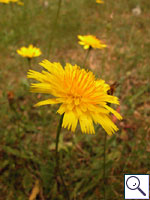|
||||||
|
HYPOCHAERIS. Cat's-ears. [Asteraceae] |
|
|
Four species of Hypochaeris are recorded in Britain. These include the native Smooth Cat's-ear (H. glabra), Spotted Cat's-ear (H. maculata) and Cat's-ear (H. radicata). The BSBI provide a downloadable plant crib for Alisma. Smooth Cat's-ear (H. glabra) is protected in Northern Ireland under Schedule 8 of the Wildlife (Northern Ireland) Order, 1985. Ten British miners are recorded on Hypochaeris. The tortricid Cnephasia conspersana is recorded as a seed / shoot feeder on Hypochaeris in Britain. A key to the European miners recorded on Hypochaeris is provided in Bladmineerders van Europa. |
|
Key for the identification of the known mines of British |
Note: Diptera larvae may live in a corridor mine, a corridor-blotch mine, or a blotch mine, but never in a case, a rolled or folded leaf, a tentiform mine or sandwiched between two more or less circular leaf sections in later instars. Pupation never in a cocoon. All mining Diptera larvae are leg-less maggots without a head capsule (see examples). They never have thoracic or abdominal legs. They do not have chewing mouthparts, although they do have a characteristic cephalo-pharyngeal skeleton (see examples), usually visible internally through the body wall. The larvae lie on their sides within the mine and use their pick-like mouthparts to feed on plant tissue. In some corridor miners frass may lie in two rows on alternate sides of the mine. In order to vacate the mine the fully grown larva cuts an exit slit, which is usually semi-circular (see Liriomyza huidobrensis video). The pupa is formed within the hardened last larval skin or puparium and as a result sheaths enclosing head appendages, wings and legs are not visible externally (see examples). See Key to non-Diptera. |
1a > Stem miner: An external stem mine with frass in two rows of disconnected strips. Pupation in stem at end of mine. |
|
Ophiomyia heringi Stary, 1930 [Diptera: Agromyzidae]. |
1b > Leaf mine. |
2a > Leaf miner: A whitish blotch mine along mid-rib, with offshoots into leaf blade. Pupation takes place at the base of the mid-rib (Spencer, 1972b: 25; Spencer. 1976: 63 (fig. 66)). The mine begins as a very narrow, upper- or lower-surface corridor, somewhere in the blade. When this hits a thick vein the larva uses this to descend towards the midrib. From that moment the lave lives in the hollow midrib. From here short, lobate corridors enter the leaf blade. The larva may move to another leaf by way of the leaf base. The corridors in the leaf are virtually free of frass (at most a few grains where they leave the midrib); frass is concentrated in the base of the midrib. Here also the pupation takes place. |
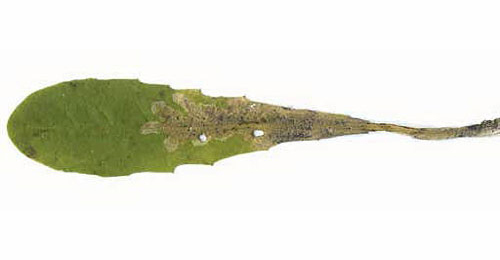 Mine of Ophiomyia cunctata on Taraxacum officinale Image: © Willem Ellis (Bladmineerders van Europa) |
|
Ophiomyia cunctata (Hendel, 1920) [Diptera: Agromyzidae]. |
2b > Leaf miner: A whitish blotch-mine along the mid-rib, with lateral offshoots into the leaf blade. Pupation at base of leaf in petiole (Spencer, 1972b: 25). Broad corridor overlying the midrib, with short excursion into the blade, mainly in its basal part. Frass concentrated in the basal part of the mine, corridors almost free from frass. Pupation in the mine, also in the basal part. |
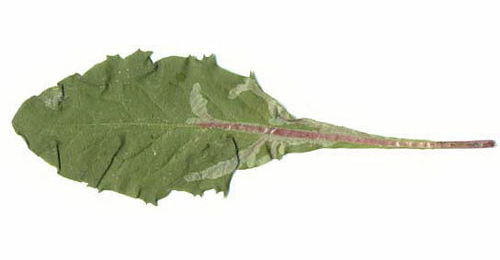 Mine of Ophiomyiapulicaria on Taraxacum officinale Image: © Willem Ellis (Bladmineerders van Europa) |
|
Ophiomyia pulicaria (Meigen, 1830) [Diptera: Agromyzidae]. |
2c > Leaf miner: Larva feeding in the mid-rib, which can swell basally, gall-like, and is frequently accompanied by reddish discolouration (Spencer, 1976: 400). Larva in a corridor in the base of the midrib, causing the midrib to swell as a gall. Pupation takes place in the mine, close to an ready made, upper-surface, exit opening. |
|
Phytomyza cecidonomia Hering, 1937 [Diptera: Agromyzidae]. |
2d > Leaf-miner: An irregular linear mine, which in small leaves can form a secondary blotch. Long, upper-surface corridor, winding through the leaf and frequently crossing itself; in small leaves often a secondary blotch in the end. Frass in short strings and pearl chains. Pupation outside the mine. An irregular gallery, sometimes crossing over, with black frass arranged as elongate very narrow streaks at the sides of the mine. |
|
Liriomyza pusilla (Meigen, 1830) [Diptera: Agromyzidae]. |
2e > Leaf-miner: A distinctive mine primarily above mid-rib, with irregular short lateral offshoots into leaf blade. Pupation external (Spencer, 1972: 51 (fig. 172), 55; Spencer, 1976: 270, 271 (fig. 486)). Branched, whitish, upper-surface corridor; main axis overlying the midrib; side branches overlying the main lateral veins. (In Campanula and Phyteuma the mine is much less branched, sometimes nothing more than a corridor on top of the midrib). Frass in rather long strings. Usually the mines begins as a long and narrow, shallow, tortuous lower-surface corridor that ends upon the midrib but otherwise is not associated with the leaf venation. Often this initial corridor is filled with callus, and then even less conspicuous. Pupation outside the mine. A linear mine on the upper surface, usually following the midrib and showing side branches along the veins. The frass is in strings. |
|
Liriomyza strigata (Meigen, 1830) [Diptera: Agromyzidae]. |
2f > Larva mining both lower and upper surface, unusually long, linear, conspicuously broad, frequently largely on the underside of the leaf. Pupation external (Spencer, 1972b: 76 (fig. 251); Spencer, 1976: 445 (fig. 780), 446). Corridor mine. The first part consists of a very long and narrow lower-surface corridor; the mine is quite shollow here, and often inconspicuous. The second part is upper-surface, uusally much shorter, and widens abruptly. Pupation outside the mine. |
|
Phytomyza marginella Fallén, 1823 [Diptera: Agromyzidae]. |
2g > Leaf-miner: Corridor-blotch mine, normally dorsal; usually whitish; in small leaves it lies characteristically in the centre of the leaf often touching the petiole; in larger leaves it lies to one side of the mid-rib. Frass deposited in green clumps near the leaf margin. Pupation usually external, sometimes in a separate pupation mine. Oviposition whitin the leaf, at the lower surface. The first part of the mine is a long, sometimes very long, corridor, that mostly will be overrun by the later developments. Generally this corridor is directed, frequently guided by a thick vein, to the midrib. The next section of the mine is large, irregular blotch overlying the basal section of the midrib. Locally large chunks of midrib tissue are consumed. From this central blotch excursions are made into the leaf blade: generally upper-surface, less often lower-surface and locally full-depth. In plants with narrow leaves, like Diplotaxis, the mine may occupy the entire width of the leaf. Often several larvae together in a mine. Frass blackish green, powdery, in clouds, sometimes along the sides of the corridors, later more in the periphery of the mine and in the end of extensions of the blotch, sometimes seemingly absent. (Often the frass can only be seen after the mine has been opened). Pupation generally in the ground, rarely within he leaf, in a short mine without frass. Hendel (1928a) described the biology, larva and puparium. An initial narrow gallery then leads to a blotch on the midrib of the leaf. Watch a video of a scaptomyzid fly larva on Arabidopsis on YouTube by mash92587. |
|
Scaptomyza flava (Fallén, 1823) [Diptera: Drosophilidae]. |
2h > Leaf-miner: The mine begins with a very narrow full depth corridor, that ends upon the midrib. Subsequently a broad corridor, or rather an elongated blotch, is made overlying the midrib; from here broad, lobe-like extensions are made into the blade. Frass in discrete grains. Secondary feeding lines conspicuous. The larva is capable of leaving the mine and restarting in a new leaf, in which case the association with the midrib may be lost. Pupation after vacation of the mine. |
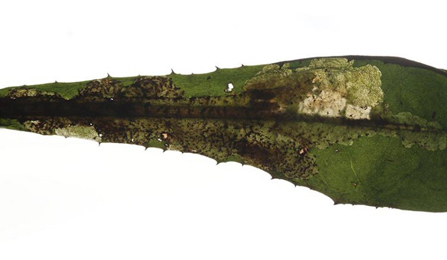 Mine of Trypeta immaculata on Taraxacum Image: Rob Edmunds (British leafminers) |
|
Trypeta immaculata (Macquart, 1835) [Diptera: Tephritidae]. |
Key for the identification of the known mines of British |
Note: The larvae of mining Coleoptera, Hymenoptera and Lepidoptera may live in a corridor mine, a corridor-blotch mine, a blotch mine, a case, a rolled or folded leaf, a tentiform mine or sandwiched between two more or less circular leaf sections in later instars. Larva may pupate in a silk cocoon. The larva may have six legs (although they may be reduced or absent), a head capsule and chewing mouthparts with opposable mandibles (see video of a gracillarid larva feeding). Larvae of Hymenoptera and Lepidoptera usually also have abdominal legs (see examples). Frass, if present, never in two rows. Unless feeding externally from within a case the larva usually vacates the mine by chewing an exit hole. Pupa with visible head appendages, wings and legs which lie in sheaths (see examples). |
1 > Leaf miner: The mine begins in the midrib, especially in a lower leaf, extending into the leaf disc, branching irregularly or pinnately, may also locally be blotch like. The mine is brown and very transparent. Sides very irregularly eaten out. Frass loosely dispersed or in a loose central line, buy may also be pressed against the sides of the corridor. The larva may also leave the mine and restart elsewhere. |
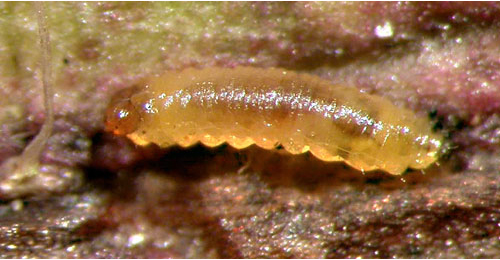 Orthochaetes setiger larva, dorsal Image: © Jean-Yves Baugnée (Bladmineerders van Europa) |
|
Orthochaetes setiger (Beck 1817) [Coleoptera: Curculionidae]. |
| Last updated 05-Jul-2019 Brian Pitkin | ||

